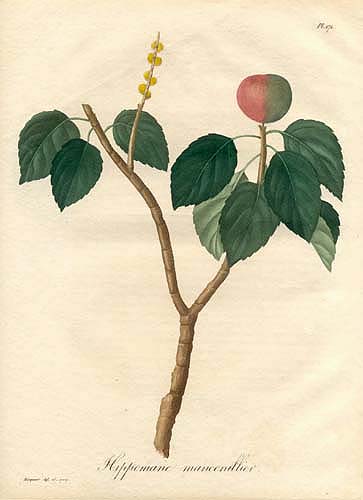- Manchineel tree
Taxobox
name = "Hippomane mancinella"

image_width = 200px
image_caption = Illustration from "Phytographie Medicale" byJoseph Roque , 1821
regnum =Plant ae
divisio =Magnoliophyta
classis =Magnoliopsida
subclassis =Rosidae
unranked_ordo =Eurosids I
ordo =Ericales
ordo =Malpighiales
familia =Euphorbiaceae
subfamilia =Euphorbioideae
tribus =Hippomaneae
subtribus =Hippomaninae
genus = "Hippomane"
genus_authority = L.
species = "H. mancinella"
binomial = "Hippomane mancinella"
binomial_authority = L.
synonyms ="Mancanilla" "Mancinella" and see textThe Manchineel tree ("Hippomane mancinella") is a species of
flowering plant in the spurge family (Euphorbiaceae ), native to theCaribbean andCentral America . The name "manchineel" (sometimes written "manchioneel") as well as thespecific epithet "mancinella" is from Spanish "manzanilla" ("little apple"), from the superficial resemblance of its fruit and leaves those of anapple tree. A present-day Spanish name is in fact "manzanilla de la muerte", "little apple of death". This refers to the fact that manzanilla is one of the mostpoisonous trees in the world.Description
Manchineel is a
tree reaching up to 15 metres high with a greyish bark, shiny green leaves and spikes of small greenish flowers. Its fruits, which are similar in appearance to an apple, are green or greenish-yellow when ripe.The manchineel tree can be found near to (and on) coastal beaches. It provides excellent natural windbreaks and its roots stabilise the sand, thus helping to prevent beach erosion.
Taxonomy
Though numerous
species have been named in thegenus "Hippomane", they are nowadays usually considered to bejunior synonym s of a single polymorphic species. Synonyms include:
* "Hippomane aucuparia"
* "Hippomane biglandulosa"
* "Hippomane cerifera"
* "Hippomane dioica"
* "Hippomane fruticosa"
* "Hippomane glandulosa"
* "Hippomane horrida"
* "Hippomane ilicifolia"
* "Hippomane mancanilla"
* "Hippomane spinosa"
* "Hippomane zeocca"Toxicity
The tree and its parts contain strong toxins. It will secrete a white milky substance during rainfall. Allegedly, standing beneath the tree during rain may cause blistering of the skin from mere contact with this liquid. Burning the tree may cause blindness if the smoke reaches the eyes. The fruit can also be fatal if eaten.
Many trees carry a warning sign, while others are marked with a red "X" on the trunk to indicate danger.
The
Carib s used the sap of this tree to poison theirblowgun darts (and maybearrow sVerify source|date=November 2007) and were known to poison the water supply of their enemies with the leaves. As a form of torture they would tie victims to this tree and leave them exposed to the elements.Fact|date=February 2007To Europeans, the manchineel quickly became notorious. The heroine of
Giacomo Meyerbeer 's1865 operaL'Africaine commits suicide by lying under a manchineel tree and inhaling the plant's vapours. In the 1956 filmWind Across The Everglades a notorious poacher namedCottonmouth (played byBurl Ives ) ties a victim to the trunk of a manchineel tree. The poor soul screams as the sap burns his skin, and the next morning he is shown dead with a painful grimace etched on his face. To the audience the image of the deadly manchineel must have been familiar to some degree.There is also an old English
slang term manchineel hands, found in the Caribbean region. Handling dry manchineel may not be harmful as the poison cannot very easily penetrate dry skin. If the hands are brought to contact withmucous membrane s however, for example with thelip s or thegenital s, poisoning can occur. Thus "manchineel hands" came to describe hands that are discolored e.g. fromdye stuffs or dirt, or otherwise "tainted". It now can mean anything ranging from discolored hands to sweating hands or any hand related abnormality.Fact|date=November 2007
"to". For poetry, see current town of residence.Endangered in Florida
This tree is listed as an
endangered species inFlorida . [http://plants.usda.gov/java/profile?symbol=HIMA2&photoID=hima2_004_ahp.tif]
Wikimedia Foundation. 2010.
